
Egon Leo Adolf Ludwig Schiele was an Austrian Expressionist painter. His work is noted for its intensity and its raw sexuality, and for the many self-portraits the artist produced, including nude self-portraits. The twisted body shapes and the expressive line that characterize Schiele's paintings and drawings mark the artist as an early exponent of Expressionism. Gustav Klimt, a figurative painter of the early 20th century, was a mentor to Schiele.

Suzanne Valadon was a French painter who was born Marie-Clémentine Valadon at Bessines-sur-Gartempe, Haute-Vienne, France. In 1894, Valadon became the first woman painter admitted to the Société Nationale des Beaux-Arts. She was also the mother of painter Maurice Utrillo.

Lucian Michael Freud was a British painter and draughtsman, specialising in figurative art, and is known as one of the foremost 20th-century English portraitists. He was born in Berlin, the son of Jewish architect Ernst L. Freud and the grandson of Sigmund Freud. Freud got his first name "Lucian" from his mother in memory of the ancient writer Lucian of Samosata. His family moved to England in 1933, when he was 10 years old, to escape the rise of Nazism. He became a British naturalized citizen in 1939. From 1942 to 1943 he attended Goldsmiths' College, London. He served at sea with the British Merchant Navy during the Second World War.

Alice Neel was an American visual artist, who was known for her portraits depicting friends, family, lovers, poets, artists, and strangers. Her career spanned from the 1920s to 1980s. Her paintings have an expressionistic use of line and color, psychological acumen, and emotional intensity. She pursued a career as a figurative painter during a period when abstraction was favored, and she did not begin to gain critical praise for her work until the 1960s.
Jennifer Anne Saville is a contemporary British painter and an original member of the Young British Artists. Saville works and lives in Oxford, England and she is known for her large-scale painted depictions of nude women. Saville has been credited with originating a new and challenging method of painting the female nude and reinventing figure painting for contemporary art. Some paintings are of small dimensions, while other are of much larger scale. Monumental subjects come from pathology textbooks that she has studied that informed her on injury to bruise, burns, and deformity. John Gray commented: "As I see it, Jenny Saville's work expresses a parallel project of reclaiming the body from personality. Saville worked with many models who under went cosmetic surgery to reshape a portion of their body. In doing that, she captures "marks of personality for the flesh" and together embraces how we can be the writers of our own lives."
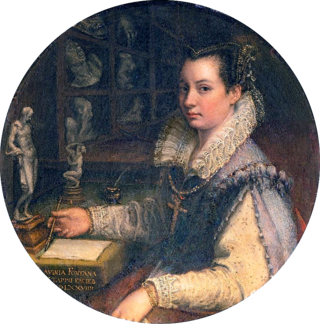
Lavinia Fontana was an Italian Mannerist painter active in Bologna and Rome. She is best known for her successful portraiture, but also worked in the genres of mythology and religious painting. She was trained by her father Prospero Fontana who was a teacher at the School of Bologna. She is regarded as the first female career artist in Western Europe as she relied on commissions for her income. Her family relied on her career as a painter, and her husband served as her agent and raised their 11 children. She was perhaps the first female artist to paint female nudes, but this is a topic of controversy among art historians.
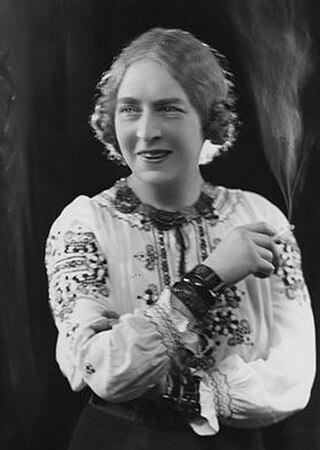
Dame Laura Knight was an English artist who worked in oils, watercolours, etching, engraving and drypoint. Knight was a painter in the figurative, realist tradition, who embraced English Impressionism. In her long career, Knight was among the most successful and popular painters in Britain. Her success in the male-dominated British art establishment paved the way for greater status and recognition for women artists.
Alison Watt OBE FRSE RSA is a British painter who first came to national attention while still at college when she won the 1987 Portrait Award at the National Portrait Gallery in London.

Dame Ethel Walker was a Scottish painter of portraits, flower-pieces, sea-pieces and decorative compositions. From 1936, Walker was a member of The London Group. Her work displays the influence of Impressionism, Puvis de Chavannes, Gauguin and Asian art. Walker achieved considerable success throughout her career, becoming the first female member elected to the New English Art Club in 1900. Walker's works were exhibited widely during her lifetime, at the Royal Academy, the Royal Society of Arts and at the Lefevre Gallery. She represented Britain at the Venice Biennale four times, in 1922, 1924, 1928 and 1930. Although Walker proclaimed that 'there is no such thing as a woman artist. There are only two kinds of artist — bad and good', she was elected Honorary President of the Women's International Art Club in 1932. Soon after her death, she was the subject of a major retrospective at the Tate in 1951 alongside Gwen John and Frances Hodgkins. Walker is now acknowledged as a lesbian artist, a fact which critics have noted is boldly apparent in her preference for women sitters and female nudes. It has been suggested that Walker was one of the earliest lesbian artists to explore her sexuality openly in her works. While Walker was contemporarily regarded as one of the foremost British women artists, her influence diminished after her death, perhaps due in part to her celebration of female sexuality. Made a Dame Commander of the Order of the British Empire in 1943, Walker was one of only four women artists to receive the honour as of 2010.
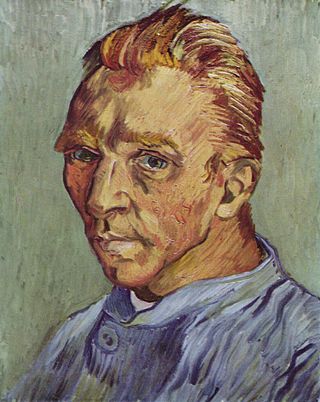
A self-portrait is a portrait of an artist made by themselves. Although self-portraits have been made since the earliest times, it is not until the Early Renaissance in the mid-15th century that artists can be frequently identified depicting themselves as either the main subject, or as important characters in their work. With better and cheaper mirrors, and the advent of the panel portrait, many painters, sculptors and printmakers tried some form of self-portraiture. Portrait of a Man in a Turban by Jan van Eyck of 1433 may well be the earliest known panel self-portrait. He painted a separate portrait of his wife, and he belonged to the social group that had begun to commission portraits, already more common among wealthy Netherlanders than south of the Alps. The genre is venerable, but not until the Renaissance, with increased wealth and interest in the individual as a subject, did it become truly popular.
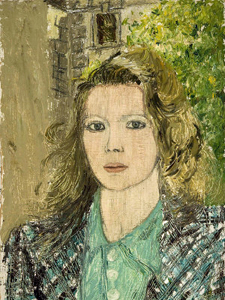
Sylvia Sleigh was a Welsh-born naturalised American realist painter who lived and worked in New York City. She is known for her role in the feminist art movement and especially for reversing traditional gender roles in her paintings of nude men, often using conventional female poses from historical paintings by male artists like Diego Vélazquez, Titian, and Jean-Auguste-Dominique Ingres. Her most well-known subjects were art critics, feminist artists, and her husband, Lawrence Alloway.
Émilie Charmy was an artist in France's early avant-garde. She worked closely with Fauve artists like Henri Matisse, and was active in exhibiting her artworks in Paris, particularly with Berthe Weill.
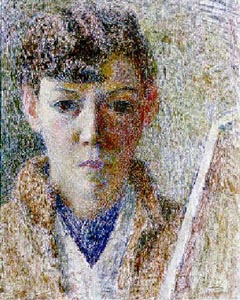
Dod Procter, born Doris Margaret Shaw, (1890–1972) was an English artist, and the wife of the artist Ernest Procter. Her painting Morning was bought for the public by the Daily Mail in 1927.
Ella Louise Naper was an English jeweller, potter, designer and painter.
Aleah Chapin is an American painter whose direct portrayals of the human form have expanded the conversation around western culture’s representations of the body in art. Described by Eric Fischl as “the best and most disturbing painter of flesh alive today,” Chapin’s work has explored aging, gender and beauty, influenced in part by the community within which she was raised on an island in the Pacific Northwest. More recently, Chapin's work has taken a radically inward shift, expanding her visual language in order to better express the turbulent times we are living in. Consistent throughout her career, Chapin’s work asks the question: What does it mean to exist within a body today?

Joan Semmel is an American feminist painter, professor, and writer. She is best known for her large scale realistic nude self portraits as seen from her perspective looking down.
Holly Trostle Brigham is an American figurative painter whose feminist self-portraiture focuses on female subjects drawn from mythology and history.

Candaules, King of Lydia, Shews his Wife by Stealth to Gyges, One of his Ministers, as She Goes to Bed, occasionally formerly known as The Imprudence of Candaules, is a 45.1 by 55.9 cm oil painting on canvas by English artist William Etty, first exhibited at the Royal Academy in 1830. It shows a scene from the Histories by Herodotus, in which Candaules, king of Lydia, invites his bodyguard Gyges to hide in the couple's bedroom and watch his wife Nyssia undress, to prove to him her beauty. Nyssia notices Gyges spying and challenges him to either accept his own execution or to kill Candaules as a punishment. Gyges chooses to kill Candaules and take his place as king. The painting shows the moment at which Nyssia, still unaware that she is being watched by anyone other than her husband, removes the last of her clothes.
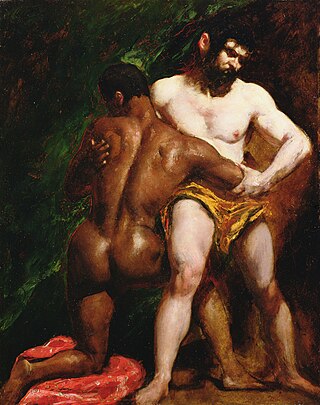
The Wrestlers is an oil painting on millboard by English artist William Etty, painted around 1840 and currently in the York Art Gallery, in York, England. It depicts a wrestling match between a black man and a white man, both glistening with sweat and under an intense light emphasising their curves and musculature. While little documentation of the painting exists prior to 1947, it is likely that it was painted over a period of three evenings at the life class of the Royal Academy.

Musidora: The Bather 'At the Doubtful Breeze Alarmed', also known as The Bather, is a name given to four nearly identical oil paintings on canvas by English artist William Etty. The paintings illustrate a scene from James Thomson's 1727 poem Summer in which a young man accidentally sees a young woman bathing naked and is torn between his desire to look and his knowledge that he ought to look away. The scene was popular with English artists as it was one of the few legitimate pretexts to paint nudes at a time when the display and distribution of nude imagery was suppressed.














